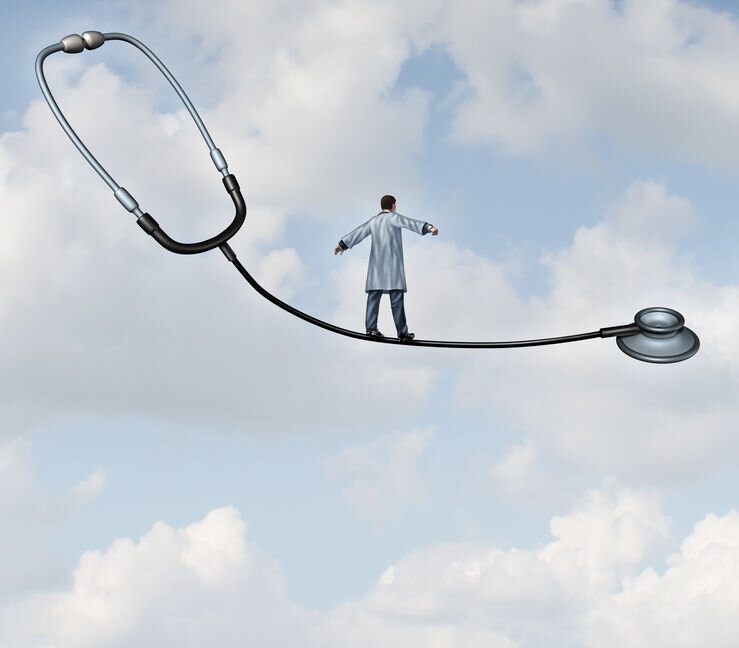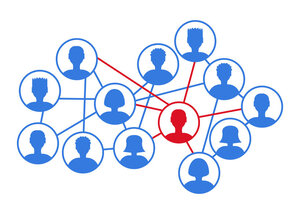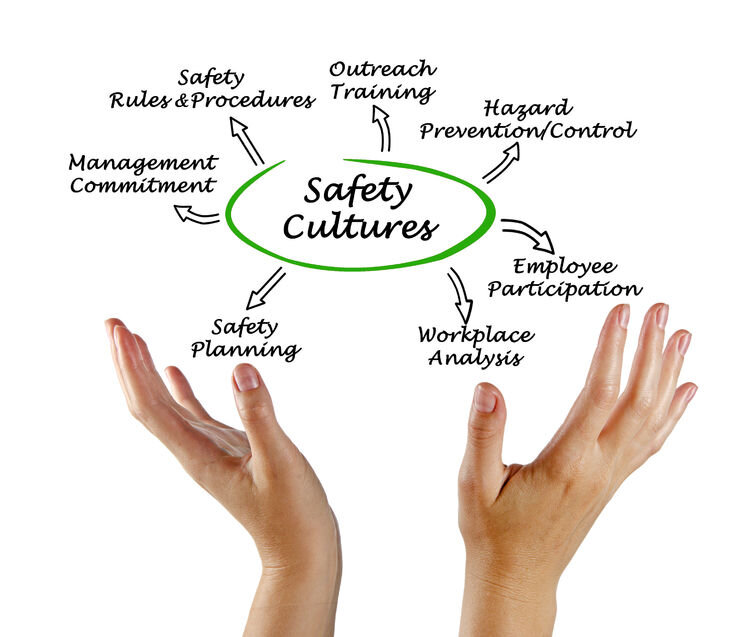
CAN AN UNHEALTHY PHYSICIAN PROVIDE YOU THE BEST HEALTHCARE?
The Atlantic reported on, “a Johns Hopkins University study [that] found physicians were less likely to talk to their patients about weight if they were overweight themselves.”
Healthcare workers are charged with caring for, and optimizing the health outcomes of the population overall. The work is challenging, stressful and high performance expectations in the face of significant resource constraints is common. Growing evidence indicates the wellness of healthcare professionals is waning and along with it a brain drain in the industry.

These trends compel us to examine the industry from the inside out and consider the cognitive dissonance of a healthcare system that is run by people who themselves are challenged to remain healthy.
A Truven Health Analytics’ report on the health of medical workers and their families found that:
Hospital employees and their dependents were more likely to be diagnosed with asthma, obesity, and depression; admission rates for asthma, obesity, and depression were 12 percent, 46 percent, and 20 percent higher, respectively, for hospital employees compared to the U.S. workforce.
We would expect healthcare workers to be the healthiest among us, but instead trends suggest they are one of the unhealthiest populations. Considering medical workers are exposed to contagious diseases, long hours, witness traumatic events and it’s no wonder their wellness is in jeopardy.
We expect them to manage their own wellness because of their professions and yet the rates of suicide and addiction are alarming among doctors, nurses and first responders. It can be argued that our culture does not adequately care for its health workers.
That’s why many researchers and scientists in the medical space are directing increased efforts and resources to promote their health and wellness. After all, who will take care of us if the medical personnel are not healthy?
What are the Largest Health Threats to Healthcare Workers?

The most significant health threats to those in healthcare come from exposure to infectious pathogens and hazardous materials, mental health challenges, and ergonomic injuries.
HIGH RISK OF INFECTIOUS DISEASES AND AGENTS
Hospital workers and first responders are regularly exposed to infectious diseases.
According to the National Institute for Occupational Safety and Health (NIOSH), some of the infectious agents that healthcare workers come in contact with are:
- Bloodborne Pathogens: Medical workers are significantly more vulnerable to HIV/AIDS, Hepatitis B, and Hepatitis C than the general public.
- Influenza: In the United States, medical workers must have a flu vaccination, but mutations in the virus can cause them to get the flu anyway.
- Ebola: Although it’s rare in the United States, Ebola is contagious and highly dangerous and most people seek treatment at the hospital.
- MRSA: Commonly known as staph infection, MRSA is extremely contagious and very prevalent in the hospital where it can spread easily.
Accidental needle sticks are the most common way medical workers are exposed to HIV, Hepatitis B virus, and Hepatitis C virus. “The risk of transmission of these diseases following percutaneous exposure among healthcare workers is significant, with HBV at 37%, HCV at 39% and HIV at 4.4%,” states the Annals of Medical and Health Sciences Research.
The advent of vaccinations and anti-viral treatments has mitigated a lot of risk for healthcare workers, but novel or uncommon infectious agents such as Ebola pose an asymmetric risk to healthcare workers when encountered.
Remember the case of Nina Pham, the Dallas nurse who contracted Ebola after caring for a patient who was diagnosed with the disease after recent return from an Ebola is endemic area.

Despite using personal protective equipment Nina Pham acquired Ebola, and nearly died, while tending to her duties as an intensive care unit nurse. Rare or novel infectious pathogens, such as Ebola or SARS, may require specialized protocols to protect healthcare workers and the presence of these pathogens may not be evident at the time of a patient’s initial presentation.
The bottom line is a few hundred healthcare workers die annually in the United States as a result of occupational exposure to infectious pathogen, but the actual numbers are underestimated because a central national registry does not exist. Lack of a central registry limits the ability to track and intervene effectively on behalf of these dedicated workers. This quote from a CDC report published in 2005 summarizes it best:
“The 9 million persons employed in the healthcare industry and their families merit better protection for their health and greater recognition for their contributions.”
EXPOSURE TO HAZARDOUS CHEMICALS
Like any other job, the healthcare industry emits harmful chemicals into the air. These chemicals do not often pose a threat to patients because they’re not routinely exposed to them. Medical workers on the other hand breath these chemicals daily.
NIOSH states that healthcare professionals often come in contact with harmful chemicals, such as hazardous drugs, ethylene oxide, formaldehyde, glutaraldehyde, anesthetic gases, surgical smoke, and latex. Many of metabolites of these chemicals are endocrine disruptors.

Reports indicate up to 18% of healthcare facilities, in one survey, use pesticides that were being phased out by the EPA due to alarmingly harmful risks to humans. Furthermore, they also breathe cleaners and disinfectants, which are used to keep healthcare facilities sanitary.
Biomonitoring of healthcare workers for chronic hazardous materials exposures is virtually non-existent and poorly understood. One startling snapshot project and report by Physicians for Social Responsibility (PSR) found toxic metabolites are present in nearly all healthcare workers tested. Although the biomonitoring project by PSR was not designed in a manner that could be applicable in general for all healthcare workers it is a noteworthy and rare publication addressing the topic of toxic chemical exposures in the industry.
MENTAL AND EMOTIONAL HEALTH

According to a study featured in the Annals of Occupational and Environmental Medicine, workers in healthcare industry had higher odds ratios for mood disorders, anxiety disorders, sleep disorders, and any psychiatric disorders than the reference group.
Perhaps most worrisome is the impact of mental disorders on medical errors, occupational injury and job turnover in healthcare.
Suicide and addiction are prevalent among doctors, nurses, paramedics, and many other healthcare professionals.
Many of them deal with burnout and sleep deprivation. They regularly see death, injury, and sickness some of which are extremely gruesome or troubling.
Imagine what first responders see at the scene of a fatal accident, or nurses caring for patients in an emergency room, or even what an oncology team experiences day-in and day-out. It’s no wonder that mental health challenges are common among healthcare workers.
More and more local stories are being published, like this one in the Richmond Times-Dispatch, reporting “many first responders suffer from PTSD and mental illness as a result of witnessing “everyday death, tragedies, and a national epidemic of mass shootings”.
According to Nurse.org, “a study released earlier this year shed light on an alarming finding: of the female population, nurses are 23% more likely to commit suicide than women in general.”
It’s also alarming that addiction is also rampant among medical professionals. The Addiction Center reports, “across the country, more than 100,000 doctors, nurses, technicians, and other health professionals struggle with addiction, mostly involving narcotics such as Oxycodone and Fentanyl.”View fullsize
NONFATAL OCCUPATIONAL INJURY AND ILLNESS
“Statistics show that a hospital is one of the most hazardous places to work.”
According to the Occupational Safety and Health Administration (OSHA) in 2011, U.S. hospitals recorded 253,700 work-related injuries and illnesses.
For first responders in the pre-hospital environment the hazards are no less. Over twenty thousand EMS professionals a year seek care for job related injuries in emergency departments. Many of the injuries experienced by EMS professionals mirror those seen inside the walls of a hospital, ranging from neck and back injuries to assault.
HOW TO TAKE CARE OF OUR HEALTHCARE WORKERS
We have to change the culture in our medical facilities, which encourages behaviors that lead to burnout, sleep deprivation, and neglect of one’s health. It’s well-known among nurses and doctors that a medical professional’s “right of passage” is working for several days without sleep. Instead, we need to take steps that advocate for sleep, exercise, regular health check-ups, and therapies that promote mental wellness.
Studies are demonstrating that health programs directed at medical professionals greatly impact their wellness. HHS Public Access reports, “moral distress, compassion fatigue, and burnout can be minimized through self-care strategies directed at the personal and professional realms.”

However, it’s important that we foster an environment that doesn’t leave the responsibilities of the healthcare workers’ wellness solely on their heads. Truven Health Analytics suggests 10 steps to establishing a culture of health:
- Analyze the health risk of your specific population: They are different for every field of study and even each clinic.
- Define goals, quantify objectives, and identify gaps based on your population’s health risk: It’s a good idea to have a diverse team that can add valuable insight into these areas.
- Build a business case based on your specific health benefit plan design
- Get buy-in from senior management
- Establish a measurement strategy
- Review, revise, and align policies and procedures to support a healthy workplace: It’s best to develop a schedule in which you reevaluate and revise your plant. Every 3, 6, or 12 months for instance.
- Design or modify programs and incentives to fit your overall goals: Many successful programs rewards healthcare workers for maintaining their health and encouraging others to be healthy.
- Develop an ongoing communications strategy using multiple channels: Teams or partners are great ways to make sure all of your medical professionals have someone checking in on them.
- Measure your progress and adjust your programs accordingly
- Ensure a sustainable culture of health

THE BOTTOM LINE
There is growing evidence, albeit limited, to suggest the health of healthcare professionals is an insidious crisis. Greater awareness and national registries of work related-illness, injuries and deaths would be a significant step in the right direction. A healthier workforce in healthcare would translate into greater safety for patients and an investment in the long term wellness of our society.
MedCognition welcomes the opportunity to explore innovation in healthcare, including the health of medical workers. In this pursuit, we are rethinking medical simulation and created a holographic patient simulator called PerSim, designed for medical simulation made realistic and simple to use.
References
Adefolalu A. (2014). Needle stick injuries and health workers: a preventable menace. Annals of medical and health sciences research, 4(Suppl 2), S159–S160. doi:10.4103/2141-9248.138046
Addiction in Medical Professionals – Addiction Center. (n.d.). Retrieved from https://www.addictioncenter.com/addiction/medical-professionals/.
CDC – Health Care Workers, Infectious Agents – NIOSH Workplace Safety and Health Topic. (2017, January 13). Retrieved from https://www.cdc.gov/niosh/topics/healthcare/infectious.html.
CDC – Health Care Workers, Chemical – NIOSH Workplace Safety and Health Topic. (2017, January 13). Retrieved from https://www.cdc.gov/niosh/topics/healthcare/chemical.html.
Courage, K. H. (2014, October 15). How Did a Dallas Nurse Catch Ebola? Retrieved from https://www.scientificamerican.com/article/how-did-a-dallas-nurse-catch-ebola/.
Ebersole, R., & Washington Post. (2019, October 28). First responders struggle with PTSD caused by emergencies, deaths, tragedies they face every day. Retrieved from https://www.richmond.com/news/trending/first-responders-struggle-with-ptsd-caused-by-emergencies-deaths-tragedies/article_dfd70cb2-991a-5ce6-9075-dfd2029b1cd4.html.
Facts About Hospital Worker Safety. (2013, September). Retrieved October 26, 2019, from https://www.osha.gov/dsg/hospitals/documents/1.2_Factbook_508.pdf.
Fung, B. (2012, August 6). Is Your Doctor Healthier Than You? Retrieved from https://www.theatlantic.com/health/archive/2012/08/is-your-doctor-healthier-than-you/260706/.
Kim, M. S., Kim, T., Lee, D., Yook, J. H., Hong, Y. C., Lee, S. Y., … Kang, M. Y. (2018). Mental disorders among workers in the healthcare industry: 2014 national health insurance data. Annals of occupational and environmental medicine, 30, 31. doi:10.1186/s40557-018-0244-x
Occupational Deaths among Healthcare Workers – Volume 11, Number 7-July 2005 – Emerging Infectious Diseases journal – CDC. (n.d.). Retrieved from https://wwwnc.cdc.gov/eid/article/11/7/04-1038_article.
Pesticides Use in Hospitals: Health Protection, Health… : Nursing Administration Quarterly. (n.d.). Retrieved from https://journals.lww.com/naqjournal/Abstract/2010/10000/Pesticides_Use_in_Hospitals__Health_Protection,.9.aspx.
Sanchez-Reilly, S., Morrison, L. J., Carey, E., Bernacki, R., O’Neill, L., Kapo, J., … Thomas, J. (2013). Caring for oneself to care for others: physicians and their self-care. The journal of supportive oncology, 11(2), 75–81.
Taylor, MD, FACP, M., & Bithoney, MD, FAAP, W. (2012). 10 Steps to Developing a Culture of Health for Hospital and Health System Employers. Truven Health Analytics, 1–20. Retrieved from https://img.en25.com/Web/TruvenHealthAnalytics/EMP_11759_0812_10steps2cultureOFhealth_WEB.pdf
Walker, A. (n.d.). Suicide In Nursing: Much More Common Than You Think. Retrieved from https://nurse.org/articles/suicide-rates-high-for-female-nurses/.
Wilding, MS, B. C., Curtis, LPN, K., & Welker-Hood, ScD, MSN, RN, K. (2018). Hazardous Chemicals in Health Care. Retrieved October 26, 2019, from https://www.psr.org/wp-content/uploads/2018/05/hazardous-chemicals-in-health-care.pdf.
5 causes of high injury rate in EMS providers. (2017, November 6). Retrieved from https://www.ems1.com/paramedic-chief/articles/5-causes-of-high-injury-rate-in-ems-providers-I6dHrLcjldehcxZe/.
About the authors:
Hector Caraballo, MD is a practicing Board Certified Emergency Physician and Chief Medical Officer at MedCognition.
Brandy Vickery is a professional medical writer with a degree in Health Administration and is currently earning a degree in English Creative Writing. She enjoys writing about medical technology, processes, and concepts that improve the healthcare industry for everyone.



